Batik of Another Name
Although the most well-known term for cloth dyed with the wax-resist process is ‘batik’ from the Javanese words ‘amba’ (to write) and ‘titik’ (to dot), the same technique in Japan is termed ‘rozome’ from the Japanese words ‘ro’(to wax) and ‘zome’ (to dye). While it may be true that a “rose by any other name would smell as sweet,” would a batik by any other name look as beautiful? The last three months of my Watson journey has been divided between Japan and Indonesia in search of the answer.
In between visiting numerous rozome masters in their studios, the majority of my time in Japan was spent at the Nara College of Arts and Crafts where I studied with rozome master Chie Otani to create my own paintings of wax and dye. Now in Indonesia, I am staying with the artist couple Nia Fliam and Agus Ismoyo in their batik studio where over 20 batik artists gather to work on a daily basis. The husband (Agus) is a descendent of royal court artisans and his wife (Nia) is an American who graduated with a degree in textile design from Pratt institute. Nia’s one year sojourn in Indonesia turned into a lifetime upon meeting Agus . Together, they have traveled the world creating and spreading their art and in fact just returned from a one year Fulbright fellowship in America. The collaboration between Nia and Ismoyo has resulted in a blending of Eastern with Western cultures, academic knowledge with spiritual feeling, masculine with feminine, traditional with modern, as well as art with craft.
Although the wax-resist process originated elsewhere, it is in Japan and Indonesia where this technique has been most thoroughly developed and integrated into the fabric of their cultural identity. Unlike Thai or Malaysian batik producers, the artists here look to their own heritage and traditions for inspiration instead of focusing on the tastes of the consumer driven western world. The finished cloth is thus a reflection of the environment from which it came – its use, design and method of production a symbol of the people who use and create them.
As a visual expression of the country’s philosophy and aesthetics, batik vs. rozome is as different as night and day. The natural elegance of Japanese kimonos, screens and ‘tableaus’ (wall panels) are in marked contrast to the closely packed designs of Indonesian sarongs, head scarves and wall hangings. It is quite obvious which culture values the Zen philosophies of simplicity, harmony and balance and which adheres to the Javanese ideals of intricacy and complexity. For a through study of rozome, it was thus necessary to study all aspects of Japanese culture, including the art of kimonos (their production as well as design), tea ceremonies, gardens, geisha society and traditional music. Similarly, it was only after experiencing first-hand the warang (shadow puppet) performances, barong/legong, kecek dances, various temples/mosques/shrines, and wedding/funeral ceremonies of Indonesia that I was able to truly understand the rich and symbolic meanings embedded into the batiks here.
In both Japan and Indonesia, batik/rozome has integrated itself to become the national clothing for both these countries. The “kimono passport” which gives discounts to those sporting the Japanese national dress is echoed on an even larger scale by the Indonesian government which requires all government officials to wear batik on Fridays and who are currently implementing batik classes into the core curriculum of public schools. The Japanese as well as Indonesians take incredible pride in this art form and even today rozome/batiks are worn and used by commoners, government officials and royalty alike. As in the past, the ornamentation and method of wearing the garment are still a symbol of the individual’s social status, position and class. Like the variety of knots in a Japanese citizen’s obi, the folds and ties of an Indonesian sarong can tell the observer which family the person belongs to, how much money they have, how old they are and whether they are single or married.
The very act of creating batik has strong symbolic meaning for the Japanese and Indonesian artisans. The difference between the two creative processes however could not be greater. Although both rozome and batik stem from an inner, spiritual plane; one is an exercise in self control and discipline while the other is a practice in letting go of all cognitive thought and inhibitions.
In Japan, even pouring a cup of tea is a meditative process which can take years to master and the “zen of archery” stresses the importance of cultivating unseen powers. If it is possible to tell the thoughts and feelings of a person just from the taste of the tea they brew, one can only imagine what is evident in each finished rozome painting! All wax-resist fabric in Japan is the result of careful thought, planning and execution. The key to success is to control the mind in order to control the body and thus the medium of the artwork. A finished piece should be a replica of the original draft and skillful execution is the sign of a true rozome master. In Japan, I learned the importance of persistence and strived for perfection. Although it took three tries, I was finally able to create a rozome piece that matched the sketch that I had planed for it to be.
While the Japanese meditate to control the mind, the Indonesians meditate to release the mind from all conscious control. In a practice the Javanese call “Kapti Kerdating Sukmo,” the creator of sacred images moves beyond their feelings and thoughts to arrive at a deeper source of creativity and make work that truly comes from the vibrations of the soul. Such artists are called “empu,” a term used to describe masters of the creative process who not only have excellent technical skills, but a deep philosophical grounding and esoteric abilities in the meditative process.
According to Javanese spiritualism, the “world” consists of three dimensions, known collectively as tribawaba. They are: jagad kecil which is consciousness within the self (microcosmos), jagad gumelar or consciousness of the surrounding environment (macrocosmos), and jagad pepadhangor which is consciousness of the ‘golden thread’ that connects humanity with the Divine Creator. In a batik created through the spiritual journey of Kapati Kerdat-ing Sukmo, the artist’s inner self merges the phenomenal world with that of the of divine dimension. From this emerges a vision seen through their inner eye that is not controlled by emotions, thoughts or cognition. In this way, the design of a batik is not only fixed to the cloth, but the meaning of it is engraved ever more deeply in the soul of the artisan. In the Kraton, or Javanese court, batik was one of the six ‘priyayi,” (high arts) studied by the cultured Javanese royalty and along with music and dance, was considered to be a way to develop spiritual discipline. During my time in Indonesia, I am trying my best to follow in the footsteps of these artists to become a “vessel” for this creative energy. Among other things, I have been participating in rituals, talking Javanese dance lessons and going to temples to round out my spiritual attunement. This is all combined with the very academic knowledge of tradition and chemistry that my teachers Nia and Agus Ismoyo bring to their instruction.
As a result of the artist’s mastery of themselves, it would only make sense that the creation of rozome is a highly individual process. Rozome masters see their work as “one of a kind,” fine art pieces (not crafts) and a way to assert themselves to the world. Japanese artists are thus renowned for their secrecy and seclusion, especially from other artists who they consider to be competitors. The art world of Japan has historically been divided into groups made up of strict hierarchies between master and apprentice. Even now it is rare for Japanese artists to exhibit with other artists outside of their core group.
This individualism is in stark contrast to the Indonesian spirit of collaboration. In Javanese, the helping of one another in mutual cooperation is called gotong royang, and is an ancient concept that has particular significance to today’s global society trying to accept ideas of hybridism, diversity and pluralism. As a nation made up of over three hundred and fifty ethnic groups, each with their own customs and languages, it would only make sense that the national motto, “Bhinneka Tunggal Ika,” (Unity in Diversity) is representative of their collaborative mindset. Indonesia’s long history of colonization by other nations and their own maritime nature of going abroad makes partnership with others a logical result of a culture that itself is the outcome of joint help and cooperation with ‘foreigners.’
One of the most fascinating characteristics of Indonesian batik are the changes in style, motif and color which has resulted from their exposure to other cultures. The indigo, brown and white colors prevalent in traditional Indonesian batiks symbolize the three main Hindu gods - Shiva (justice), Vishnu (wisdom) and Brahma (power). Images of birds, lotus flowers and tree life also came from Indian origins and were prevalent until the 17th century when designs became more geometrical and botanical as a result of the Islamic ban against depictions of people or animals. When Indonesia became a Dutch colony in the later half of the century, the European culture also influenced batiks and even the Japanese occupation of Indonesia (1942-1945) has changed the face of batik in Indonesia. Highly influenced by Japanese designs and motifs, this new category of “Batik Hokokai” is characterized by fine intricate backgrounds and beautifully designed flowers.
Batiks in Indonesia are almost always the result of the collective energy of a group and collaboration is seen as an integral aspect of the creative process. Even the work of a single artist is considered to be in collaboration with the “creative energies” of all empu. My hosts, Nia and Ismoyo thus think of themselves as vehicles for the invisible creative forces and the conjoined energy of all people involved in the creative process. They work together with the 20+ artists of their studio, Brahma Titra Sari (BTS) on a daily basis and have partnered with aboriginal artists from Australia, Malian and Nigerian artists in Africa and only recently finished a Fulbright Fellowship with American students from Western Michigan University.
Although I am trying my best, it has been difficult to let so of my Western, liberal arts educated background which stresses individualism, ownership and conceptual expression. The need to stand apart from others, assert my thoughts and protect my “rights” is the result of my American upbringing and completely contradictory to the Javanese ideal of collaboration. It has thus been a constant struggle to suppress my individual ‘voice” for the sake of the collective and the fear of letting go of control and beliefs is often overwhelming to the point of paralysis.
The drastic differences between the creative process of rozome and batik leads to or perhaps results from the difference in materials and tools that are utilized. The large, balanced compositions of pristine colors in rozome paintings are only possible when the entire fabric is stretched tightly over a frame and the wax painted freely with brushes of natural fiber. Since the dyes are brushed directly onto the cloth, there is no danger of the wax cracking and the brittleness of paraffin wax is overlooked for it’s clear and clean properties. Conversely, batik artists in Indonesia sit on low stools with the cloth they are working on draped over a bamboo frame called gawangagan and use only the surface area of one hand as canvas while the other hand holds the canting (pronounced tjanting) tool – a wax pen from which intricate lines and dots are drawn. The complex designs of Indonesian batik is further aided by the use of caps – copper stamps dipped in hot wax and pressed onto cap tables of cool, damp sponges. The flexibility of un-stretched fabric helps to prevent the wax from breaking and allows for easy immersion into dye baths. Instead of paraffin, the wax here consists of sticky and flexible resin and oil, further insuring that it does not crack in the dying process. The lack of control in the use of open-holed canting tools and dye immersions would drive a rozome artist crazy - but for the Indonesian craftsperson, this spontaneity is ideal and the result is pure magic.
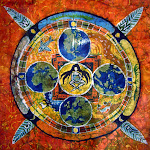


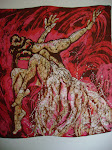

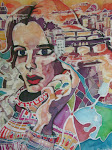
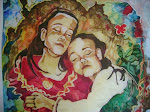

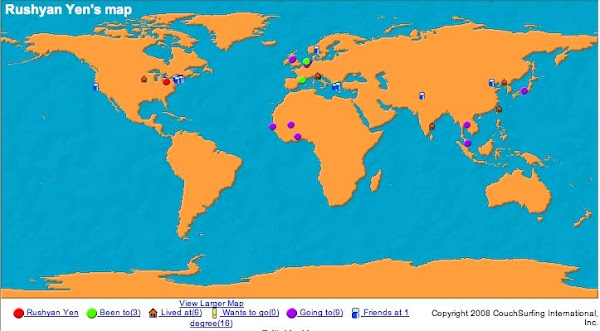
2 comments:
Hi Rushyen,
As soon as I saw your email in my mailbox, I rushed to your blog hoping to find your next quarterly report! ^o^ I was not disappointed. That was an incredibly fascinating read! I really hope that once you've finished your world tour, you consider bringing together all the work you've done in the blog as well as the photos you've taken and publish a book. It would be incredibly fascinating!
-Kevin
Wow, Rushyan - completely echo what Kevin says - completely fascinating. I have been interested in rozome for a long time but only came across one rozome artist's work when I was in Japan - Very interesting to read the differing cultural backgrounds between Japanese and Indonesian batik. OK, now I have to go and read all about rozome in your previous posts! In your travels/research do you know of other countries that have such strong cultural connections with batik?
Post a Comment